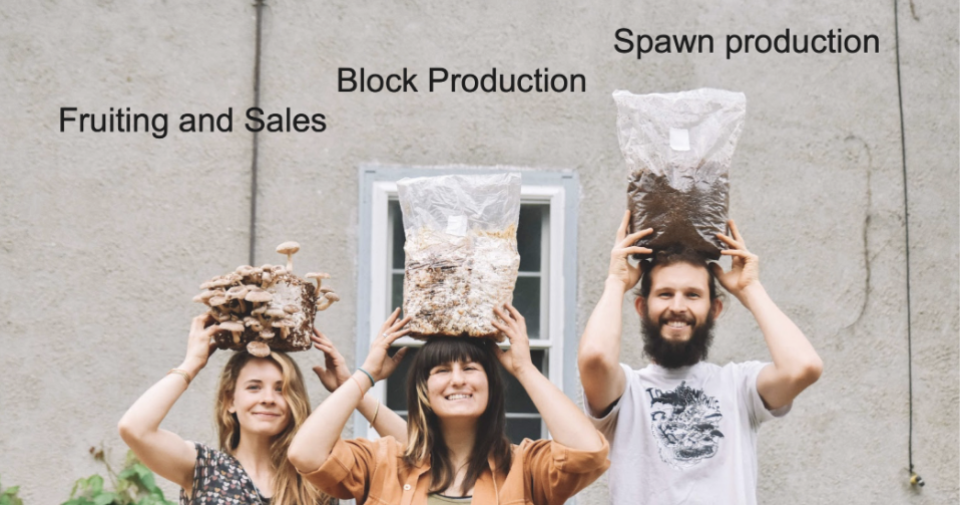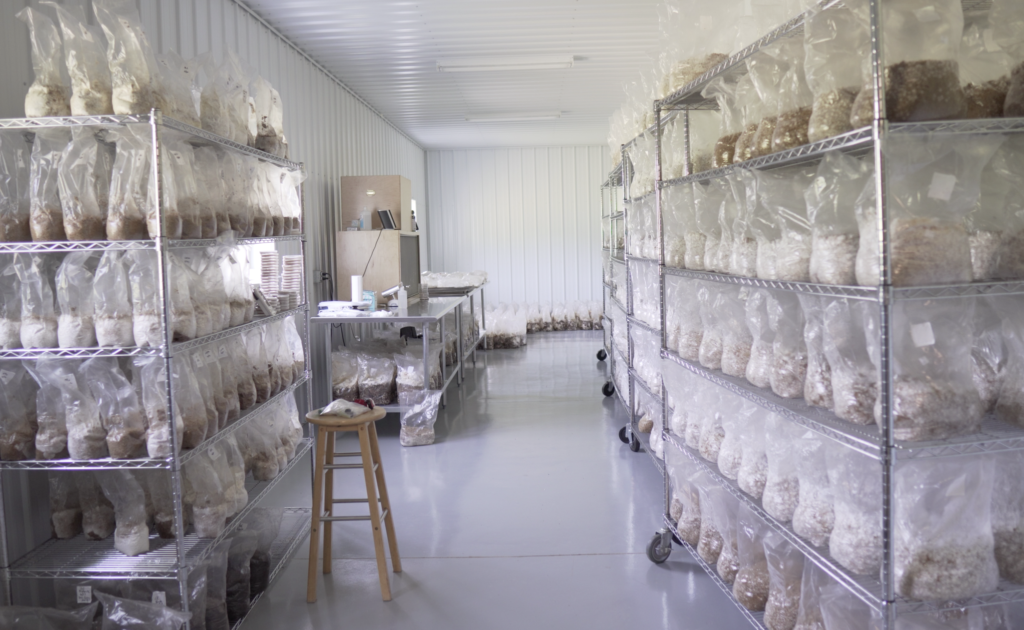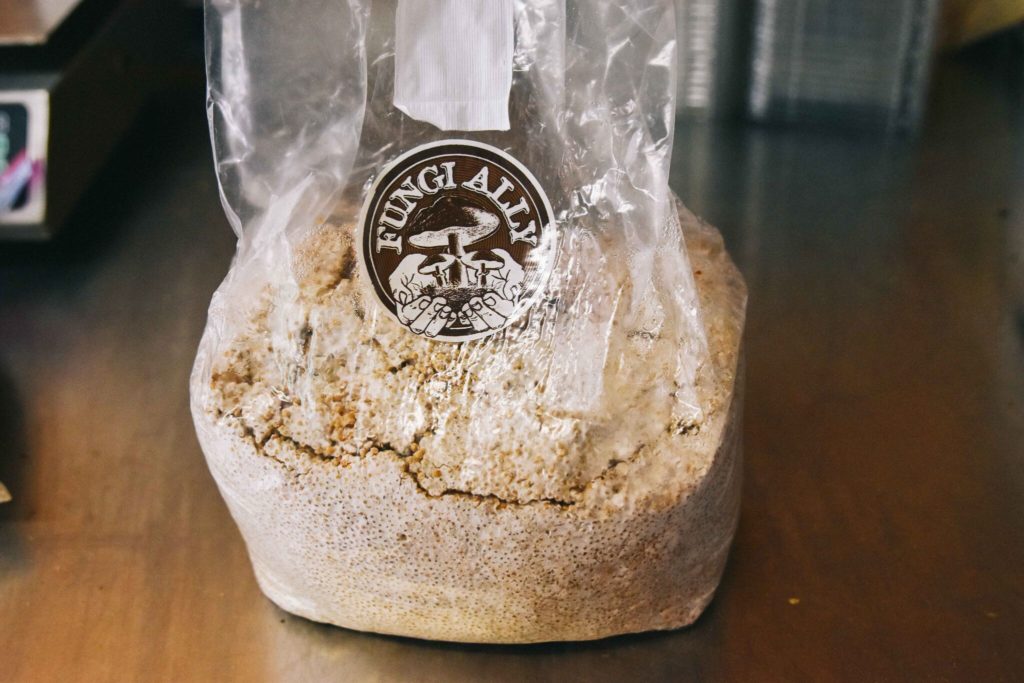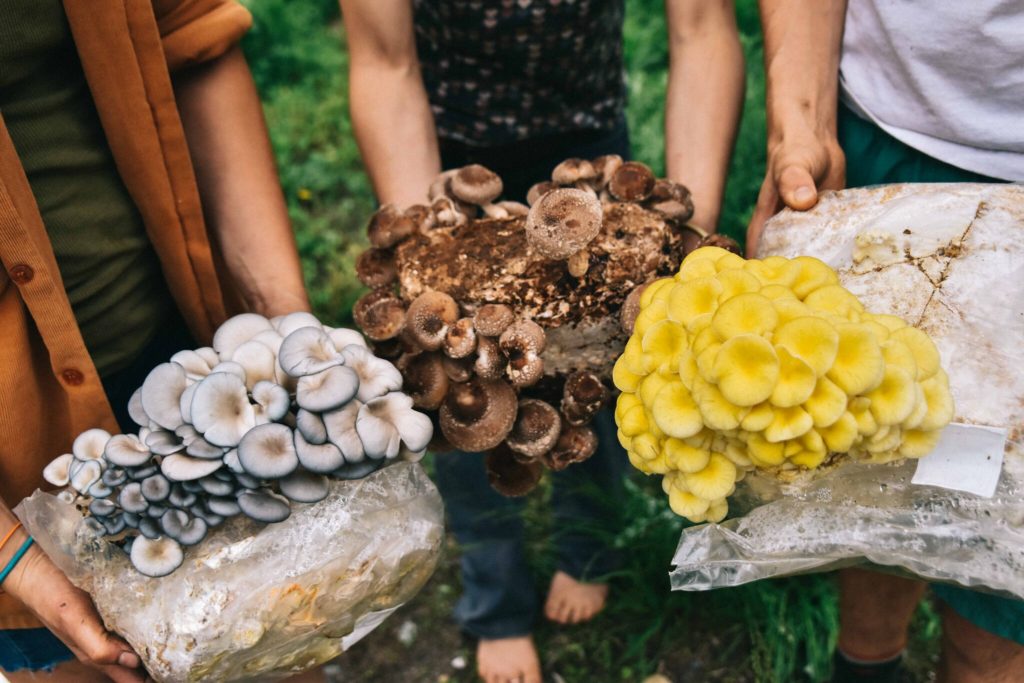The Three Sectors of the Specialty Mushroom
Starting an enterprise in specialty mushrooms doesn’t require you to do everything!
When thinking about growing mushrooms it is important to know that most businesses do not do the entire process of cultivation in-house. Depending on the mission and goals of a cultivator, the involvement in each of these processes may change. There are three different sectors of the commercial mushroom industry:
- Spawn production
- Block production
- Fruiting and sales

Three stages of specialty mushroom production.
Courtesy of Fungi Ally
Each of these three sectors can require completely different infrastructure, skill levels, and contacts to operate successfully. As the small-scale specialty mushroom industry grows, there continues to be more specialization and focus for individual businesses.
Example 1: A farmer has a 300-person CSA and wants to offer their customers mushrooms. They need 60 pounds of mushrooms per week. Rather than put a lot of time and resources right away into producing spawn and fruiting blocks, they can simply buy ready-to-fruit blocks. This allows the farmer to expand upon an existing market and develop their skills in fruiting mushrooms and managing sales. This method is also very easy to scale. If the farmer wanted to start selling 10 pounds each to four of their restaurant customers, they could easily increase the amount of blocks they are purchasing.
Example 2: A college grad wants to focus on e-commerce and mycoremediation. Fresh mushrooms do not ship well and are a by-product, not the focus of mycoremediation. Rather than trying to start a mushroom production farm, they focus on growing and offering spawn. Instead of investing in infrastructure to sell mushrooms, all of their time, energy, and resources go into producing spawn to be sold online and used in mycoremediation projects around the country.
Example 3: Two entrepreneurs see the potential for the expanding mushroom industry and strategically place 20 block-production facilities around the country to reduce shipping costs so every farm can economically grow specialty mushrooms outside or in an unused barn. They don’t have the channels to sell fresh mushrooms, so they focus on producing blocks for farmers to fruit mushrooms from.
Choose Your Own Adventure
Breaking specialty mushroom cultivation into these three categories can be extremely helpful for anyone starting their own farm or anyone interested in supplementing an existing business with mushrooms. The size of the farm, combined with your mission and goals, will dictate which aspects are done on the farm. As a grower becomes more established and increases the size of their production, it might make sense to shift more to on-farm production. This is a great way to design opportunities of growth into the business without needing to find new customers.
For Example: A grower has purchased ready-to-fruit blocks for the first two years of production, going from selling 50 pounds per week to 200 pounds per week. They have been working 20 hours per week with one employee and now are ready to put more time and resources into production. The blocks they have been buying in have cost about $7 each. They can produce them in house for $3.50 per block.
- Current annual expense for blocks: $72,800
- Annual expenses for producing in-house: $36,400

Sterile facility necessary for consistent spawn and block production.
Courtesy of Fungi Ally
Making this change could increase profit by $36,400 per year! This would not require finding new customers, but rather investing in infrastructure and employees. In a single year the $36,000 saved from no longer buying in blocks could cover the expenses associated with creating a space and on-boarding employees to produce blocks in-house. As a result, the long-term profitability of the business would be improved. When the grower was producing 50 pounds per week, the cost differential between buying in blocks versus producing in-house was only $9,100 per year, which may not have been worth the extra stress, labor, and investment to produce the blocks.
Building relationships within the industry is extremely useful for weathering the storms of mushroom production. Every farm experiences loss and contamination. It is great when there are other businesses that help create resiliency within the industry. By networking and building relationships with farms at different levels, a grower becomes more resilient. If they lose spawn or blocks to contamination or are short on fresh mushrooms they can work with their neighbor to fulfill their orders. Likewise, if a grower over-produces, they can work with neighboring farms to offer their surplus. By collaborating, the movement of specialty mushrooms becomes stronger.

Spawn is mycelium ready for inoculations on a farm.
Courtesy of Fungi Ally
Spawn Production
Spawn production is the most specialized and finicky aspect of specialty mushroom production. Spawn is produced on high-nutrient materials like agar and grain. Spawn is mycelium that is used to inoculate a new substrate. It can come in many different forms: agar, grain, sawdust or plug. It is very important when growing mushrooms that spawn does not contain other microorganisms. If the spawn has trace amount of mold or bacteria, those contaminants will expand exponentially into the bulk substrate. If a 10–pound bag of spawn that is contaminated is used, now there will be 300 pounds of contaminated substrate! Not only are all of those materials and time wasted (especially if you don’t learn from the mistake), but all the material needs to be thrown out in the compost.
The materials used in spawn production can easily be infected by microorganisms that are all around us like molds, yeasts, and bacteria. Because of this, very particular infrastructure and methods are needed in spawn production. It is an advanced part of mushroom production and needs constant focus and attention. For small-scale and beginning growers, it can make more sense to purchase spawn from another company. This frees up time for other aspects of cultivation or to do something other than farm!
Let’s take a look at the economics:
10 lb. of grain spawn = $20
Shipping 10 lb. bag of spawn = $10
Total cost per 10 lb. of spawn= $30
10 lb. of spawn can inoculate 150-300 pounds of substrate.
150-300 pounds of substrate = 30-60 lbs. of mushrooms
Spawn costs are .50 to $1 per pound of mushroom.
If producing 100 pounds of mushrooms $100-50 would be spent on spawn while grossing around $1000 in sales. Could 10 pounds of spawn be produced for less than $100 per week? Probably not. But 50 pounds of spawn could be produced for less than $500 per week. It is all a matter of scale, and what the grower wants to spend their time on.

Ready-to-fruit blocks offer an easy, yet cash flow heavy, starting point.
Courtesy of Fungi Ally
Block Production
After producing spawn, the next step in mushroom cultivation is to produce the bulk substrate or fruiting substrate or simply blocks. This is the material the mushrooms are going to fruit from. There are several factors that play into producing high quality blocks:
- Finding low cost sources for substrates.
- Providing the proper nutritional recipe for the mushrooms to grow.
- Treating, inoculating, and incubating the blocks properly until they are ready to fruit.
When broken down into individual tasks, there are over 60 steps that go into producing blocks, starting from sourcing and storing materials all the way to initiating fruit body formation. The most common substrates used in block production are straw, sawdust, soybean hulls, and wheat bran. Buying these in bulk helps to reduce cost, but storage then becomes a necessity. Developing a formula optimized for maximum fruiting and mycelial run can be a challenge when starting out. Formulas will be explored in more depth in the second booklet. The process of mixing, inoculating, and incubating blocks can be time and equipment intensive. Many farms do not have the time, space, or resources to begin producing blocks from the start.
There are typically two sizes of ready to fruit blocks that can be purchased: 5 lb. and 10 lb. On average, 5–pound blocks fruit one pound of mushrooms per block, and 10–pound blocks fruit about two pounds per block. Oyster mushrooms can greatly outperform this metric, but when doing projections, these are achievable numbers to use. Typically, the blocks cost between $4.50-$7.50, depending on the size, plus shipping. When buying blocks in, it is extremely helpful to work with someone who can deliver directly or offer easy pick-up to decrease shipping costs. Shipping costs can also be limited by buying a whole month’s supply of blocks at a time and storing them in a cooler. Blocks are initiated once or twice a week as needed. After about three weeks in the cooler, they typically start to fruit in the bag, decreasing overall yield.
Some growers do a combination of buying and producing their own blocks. Long incubation species like shiitake can use a lot of space. Purchasing shiitake blocks while producing oysters can be a good introduction to in-house block production. Other times, specialty species for a particular event or CSA can be bought in for a on- time production run.
One downside to purchasing blocks is that it does require some cash flow. There is typically an 8 to 12–week window between buying the blocks and being paid for the mushrooms. This means that if you are growing 50 pounds per week at $7 per block and you are receiving a 1 lb. yield per block, there will be around $2,800-$4,200 tied up in cash flow.
Fruiting and Sales
The easiest aspect of mushroom cultivation to dive into is fruiting and sales. This entails creating a favorable environment for mushrooms to fruit, and then growing, harvesting, storing, and selling the mushrooms. Exclusively doing this step is still a lot of work! Especially when starting out, it can be really helpful to focus on dialing in the conditions to fruit the mushrooms. By observing and working with the mushrooms in the fruiting room, a grower learns how the mushrooms respond to different environmental factors. The grower will learn how to schedule and predict fruitings as well as manage the boom and bust that can happen in mushroom production. This stage is also key in developing a brand and customer base. Many specialty mushroom farms choose to be organic and focus on a higher-end clientele. Having a nice logo and good packaging can really help to create a known brand.
Creating a business focused exclusively on this aspect of specialty mushroom production greatly reduces the infrastructure needed to get started. All that is needed is a walk-in cooler and fruiting room that can be in the basement, barn, or even outside for 3-season growing. For some farms this would mean just setting aside some space in the woods and starting to grow. A grow room and walk- in cooler can easily be built for between $1000-$5000, depending on your budget.
In this area there is also the opportunity to focus on and produce value-added products like mushroom body products, extracts, soups, teas, and dried mushrooms. These products are becoming more popular in e-commerce, farmers markets, and stores around the United States. Teaming up with a mushroom farm to produce these or focusing on fruiting and value-added production is a great market to explore. There are few farms doing it, lots of growth in the market, and grant monies available to assist in developing and promoting value added products.
This article was co-written by Steve Gabriel and Willie Crosby.
Steve Gabriel is an extension specialist in Specialty Mushroom production and leads the research and education effort at Cornell Small Farms. He is also co-owns Wellspring Forest Farm which produces mushrooms, pastured lamb, maple syrup, and duck eggs for local markets.
Willie Crosby is a co-founder of Fungi Ally and is involved with research, education, and mushroom production. Through study and experience Willie hopes to continue learning the diverse methods people can improve themselves and the world through allying with fungi!
This material is based upon work from the Cornell Small Farms Program and Fungi Ally, supported by the National Institute of Food and Agriculture, U.S. Department of Agriculture, through the Northeast Sustainable Agriculture Research and Education program under subaward number LNE19-376.
It is an excerpt from a longer series of two informational booklets that are available for free online at http://cornellmushrooms.org/.

